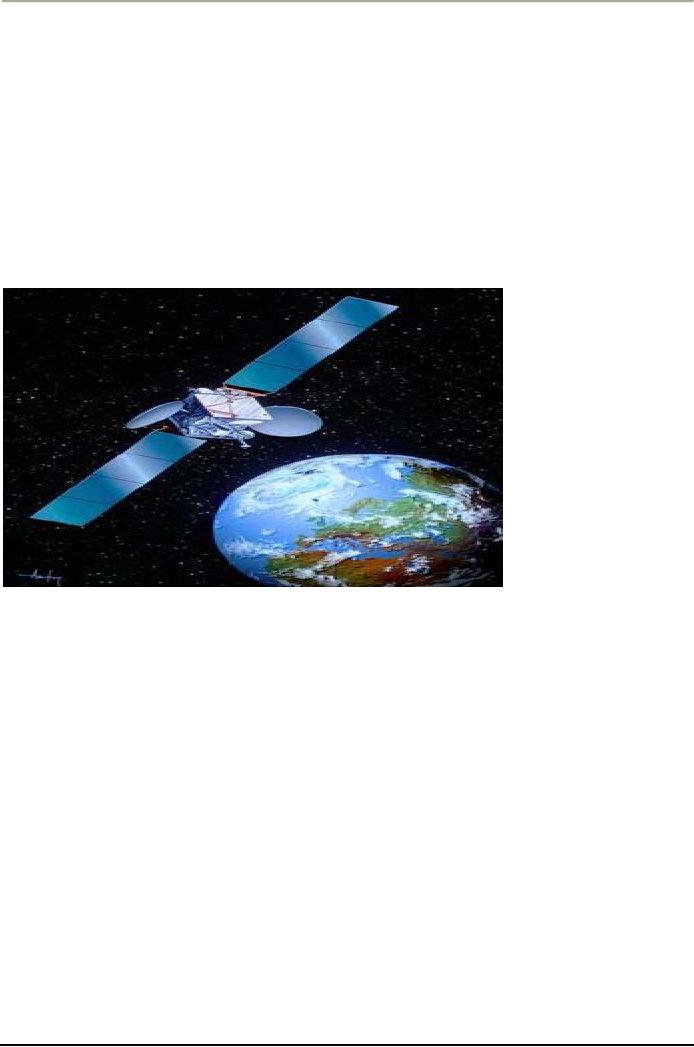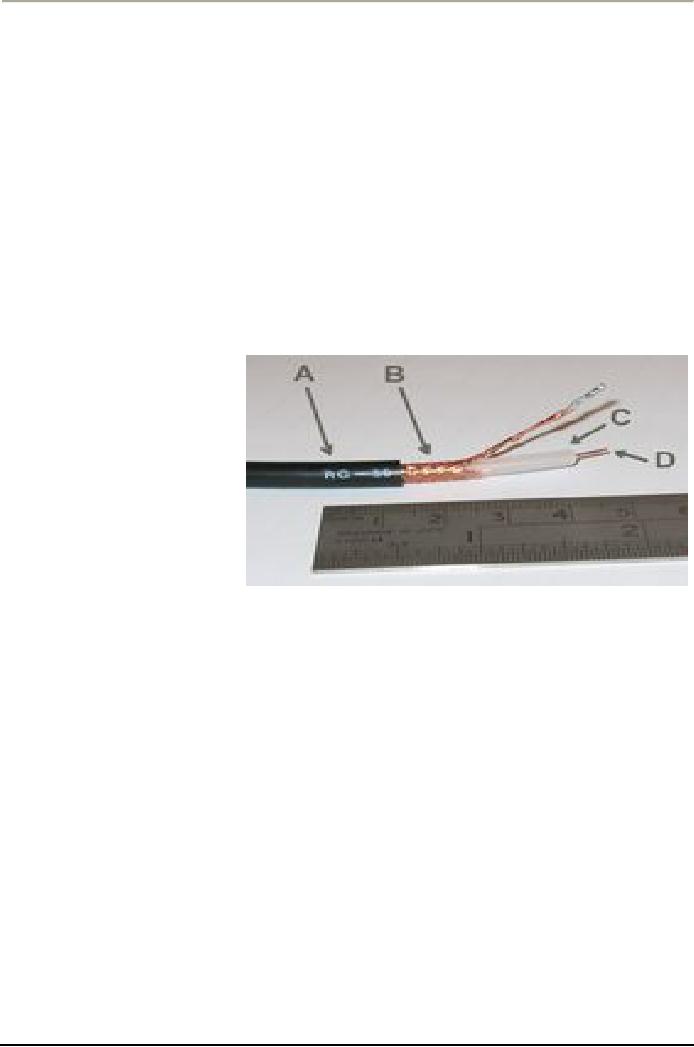 |

Introduction
to Broadcasting MCM
411
VU
LESSON
43
TERRESTRIAL TO
SATELLITE TO CABLE TV
It is
not very long ago
that the TV transmission was
initiated. Not even hundred
years of
history
could be attached with the
television broadcast. The
fact that TV broadcast
started in
1927
when only mechanical TV sets
were doing the magic of
showing the moving images
of
very
primitive nature, looks very
strange as we see the
rapidly advanced form of
television
transmission
across the world
today.
The
TV transmission has passed
through different phases of
development thanks to the
great
work
done by scientists in the
field of telecommunication.
In
the paragraphs below we
shall see various forms of
TV broadcast and the
progress which
has
been made in propagating the
TV signal in different
ways.
Terrestrial
TV broadcast
The
very first form of TV
broadcast is on-the-air. A transmitter
high in the air would
throw the
electromagnetic
waves carrying the TV
signals which would travel
on the principle of
line-in-
sight.
This means, the waves
would move in a straight
line. They would end, or
lose their
energy
after hitting the ground
due to the curvature of the
earth. So higher a transmitter
more
distance
it could cover to send
signals which could be
caught by the TV sets in
most cases.
People
would use ordinary antennae
which are generally fixed at
the roof tops to get a
little
stronger
signal and through a semi
flexible wire the signal
would go to the TV set where
it
would
be decoded accordingly and
viewers are able to see
the transmission.
The
antenna has to be pointed
towards the transmitter. And in
areas where signal had
been
weak,
people would do strange
things attaching different
metallic objects with the
antenna to
strengthen
the signal and no surprise
it worked sometime. Stormy
and rainy evenings
would
change
the antenna direction and
spoil the evening joy of
watching your favorite
program.
Till
1950 the world did
not know any other
method of catching a TV signal
when Community
Access
TV (CATV) was introduced in
the USA. The new
system was just an amended
form of
the
terrestrial broadcast. The
only difference was that a
strong antenna was mounted
at the
top
of a mountain to receive a clear
signal from a TV transmitter
and then multiple numbers
of
TV
sets at different houses and
offices were linked to it
through coaxial wire. But
that was
basically
sharing of the terrestrial
broadcast signal in an amended
form.
There
are still a high number of
television stations around
the world which are
doing on-the-air
or
terrestrial broadcast, especially in
the thickly populated urban
areas this mode of TV
broadcast
is very much in vogue and
people can enjoy a TV
broadcast without any
interference
or to depend on any other
source for providing the TV
services.
130

Introduction
to Broadcasting MCM
411
VU
Satellite
TV a revolution in TV
broadcasting
The
problem of not being able to
send TV signal at a greater
distance had always been
an
issue
of concern. The microwave
links were created to relay
stations and enlarge the
scope of
TV
broadcast but still it was
far from
satisfactory.
Experiments
to use the spaceships in
some manner to pick and
redirect TV signals to
the
earth
in the early 1960s bore
fruit.The first satellite
television signal was
relayed from Europe
to
the Telstar satellite over
North America in 1962. The
world's first
commercial
communication
satellite, called Early
Bird, was launched into
the orbit on April 6, 1965.
Early
Bird's
design was built for
the National Aeronautics and
Space Administration to
demonstrate
the
feasibility of communications from
the orbit. On station in
orbit 22,300 miles above
the
equator,
Early Bird
provided
line of sight
communications
between
Europe and
North
America.
<=A
satellite orbiting
around
earth for
sending
down TV
signals
Satellite
television, like
other
communications
relayed
by satellite,
starts
with
a
transmitting
antenna
located
at an uplink
facility.
Uplink satellite dishes are
very large, as much as 9 to 12
meters (30 to 40 feet)
in
diameter.
The increased diameter
results in more accurate
aiming and increased
signal
strength
at the satellite. The uplink
dish is pointed toward a
specific satellite and the
up-linked
signals
are transmitted within a
specific frequency range, so as to be
received by one of
the
transponders
(devices which receive and
redirect signals) tuned to
that frequency range
aboard
that satellite. The
transponder 'retransmits' the
signals back to Earth but at
a different
frequency
band (to avoid interference
with the uplink signal),
The leg of the signal
path from
the
satellite to the receiving
Earth station is called the
downlink.
Ever
since many a countries have
set up their satellites in
the space which keep
their fixed
position
by moving at a speed which
corresponds to the revolution-speed of
the earth at its
axis.
The
presence of satellites opened
gates for hundreds of
channels to million of viewers
across
the
world who could enjoy
different TV broadcasts without
much cost. The only
thing they
needed
is to have a small dish at an
open place pointed towards a
satellite and attached to
a
special
receiver for decoding the
very high frequency signal
to ordinary range of
frequencies
which
a TV set can read
easily.
131

Introduction
to Broadcasting MCM
411
VU
But
the TV channels which were
very popular around the
world, especially sports
and
entertainment
channels, started encrypting
their service which meant
that now a viewer
needed
to have a decoder, which
cost reasonably, to watch
those stations. One by one
almost
all
the good channels went on to
decoders. The free-to-air
channels which are
available
through
satellite are usually news
channels or those which
enjoy little popularity. The
boom of
satellite
channels for ordinary and
low income viewers was
over and the dishes
and receiver
sets,
bought at a reasonable cost,
were rendered a junk.
Cable
Network
But
before viewers bemoan
themselves much, there came
the concept of the cable
network
operations.
These are small
organizations which invest on
equipment which can catch a
range
of
TV broadcast the terrestrial,
satellite or any other. All
the channels are brought to
one
point
and through fiber optic or
coaxial wires which
can carry a high number of
signals put at
different
frequencies, to any point in
distance where an ordinary TV
set can decode
this
signal.
A
specimen of coaxial
wire
used
by cable operators to
carry
multiple TV signals =>
With
the arrival of
cable
service,
though always a
limited
area operation,
the
viewers
are in a position to
enjoy
TV transmissions of
many
dozen stations at a
very
nominal
cost.
But
there have been problems
with cable operators. They
some time miss a station
you want
to
see, or run programs which
you do not want to see.
They sometime do breach of
law,
ethics
and irritate people by
sending in signals of recording
programs which are
high
offensive.
At times, during sporting
events, they run commercials
at crucial points of the
game.
CD
Channels
These
are not production or
broadcasting houses like a TV
station. This practice is
done by
local
area cable operators who
need a small place to run
recorded materials- songs,
dramas,
concerts
etc, and pick the
signal for transmitting
through the coaxial wire to
the subscribers.
For
a viewer this is like a
channel because it would
occupy a channel slot of the
TV set. Cable
operators
may have any number of
such channels. They do this
practice for saving money
of
decoders,
or add attraction. In this
quest sometime they ignore
ethics on piracy and
social
norms
and are criticized strongly
by offenders.
132
Table of Contents:
- BROADCASTING:Historical Facts about Radio, Wireless and Radio
- CLASSIFICATION OF PROGRAMS:NEWS, Language, Sensationalizing
- CURRENT AFFAIRS:Talk Shows, Discussions, Seminars, Live Shows
- OUTDOOR BROADCASTING I:VIP Movement, Suddenly Assigned Events
- OUTDOOR BROADCASTING II:Pakistan Day March Past, General Elections
- CURTAIN RAISER:Political, Financial, Sports, Academics
- RADIO FEATURE:Personality Features, Features on Events
- MUSICAL PROGRAMS:Classical Music, Light and Film Music, Folk Music
- RADIO DOCUMENTARY:Narrative, Dramatized, Imagination, Close to places
- DISC JOCKEY:Women in Focus, Daily/ Weekly Division, Making Titles
- VOICE IN BROADCASTING:Speech, Accent, Loudness, Stress
- NOISE:Physical, Medium itself, Problem at sender’s end, Semantics
- STUDIO:Drama Studio, Studios for Talk Shows/ Discussions, Music Studios,
- RADIO DRAMA I:Stage Dramas, Early Radio Dramas, Ethics, Classification
- RADIO DRAMA II:Selection of director, The Playwrights, Script, Voices
- ADVERTISEMENT – INCOME GENERATION:Similarities, More Analysis
- ADVERTISERS’ APPROACH:Dramatized, Dialogue based, News
- FM – A NEW GENERATION IN BROADCASTING:Low Cost, The Difference
- MICROPHONE TO TRANSMITTER:Amplifiers, Modulator, Transmitter
- WRITING SCRIPT FOR RADIO BROADCAST:NEWS Script, Interviews
- INTERACTIVE BROADCASTING:On-line, E-mails, Interview, Views in News
- REVISION:CURRENT AFFAIRS, RADIO FEATURE, MUSICAL PROGRAMS
- HISTORY OF TELEVISION:Early History, The Black & White Images, Color Television
- PAKISTAN TELEVISION (PTV):The Excitement, Timing, Live Broadcast
- BROADCASTING LAWS:Laws in the 19th century, Press Council of Pakistan
- REPLICAS OF RADIO BROADCAST:The Staff, News Reading, Programming
- NEW SCRIPT WRITING AND DIRECTION TECHNIQUES:TV Script
- SETS:Permanent Sets, Hot & Cover Sets, Special Sets, Economical
- CAMERA SHOTS – THE VISUAL LANGUAGE:Angle Shots, Movement shots
- LIGHTS IN VISUAL BROADCASTING:Light Temperature, Light and Distance
- INTERIOR AND EXTERIOR:NEWS and Interviews, Dramas and Music
- BROADCASTING AND MEDIA IMPERIALISM:The truth in the debate
- ENVIRONMENT OF TV BROADCAST:Optical Illusions, POV, Depth of Field
- BUDGET:First Part, Second Part, Third Part, The Sponsors
- COMPARISON AND CONTRAST OF DIFFERENT RADIO AND TV FORMATS:TV NEWS
- CURRENT AFFAIRS – FROM RADIO TO TV:Seminars, Interviews
- PRE-PRODUCTION:Brain Storming, Scripting a new program, Approval
- PRODUCTION & POST-PRODUCTION:Booking Shifts, Rehearsals
- TV ADVERTISEMENTS – MONEY WITH ENTERTAINMENT:Early Phase, Getting Spots
- ENIGMA OF MORE CHANNELS:The Investment, Fresh Ideas, Closure of channels
- ANCHORPERSON:Appearance and Confidence, Job Opportunities
- COMPARISON BETWEEN RADIO AND TV BROADCAST:The Difference, Script
- TERRESTRIAL TO SATELLITE TO CABLE TV:Cable Network, CD Channels
- CAREER IN BROADCASTING:Production, Direction, Lighting Director, Script Writer
- REVISION (LESSON 23 TO 44):Broadcasting Laws, PEMRA, Budget